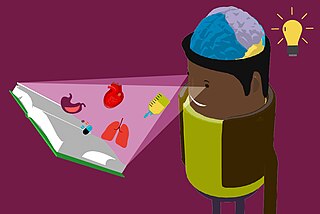Related Research Articles

The picture superiority effect refers to the phenomenon in which pictures and images are more likely to be remembered than are words. This effect has been demonstrated in numerous experiments using different methods. It is based on the notion that "human memory is extremely sensitive to the symbolic modality of presentation of event information". Explanations for the picture superiority effect are not concrete and are still being debated.
Belief bias is the tendency to judge the strength of arguments based on the plausibility of their conclusion rather than how strongly they support that conclusion. A person is more likely to accept an argument that supports a conclusion that aligns with their values, beliefs and prior knowledge, while rejecting counter arguments to the conclusion. Belief bias is an extremely common and therefore significant form of error; we can easily be blinded by our beliefs and reach the wrong conclusion. Belief bias has been found to influence various reasoning tasks, including conditional reasoning, relation reasoning and transitive reasoning.

In sociology and social psychology, an in-group is a social group to which a person psychologically identifies as being a member. By contrast, an out-group is a social group with which an individual does not identify. People may for example identify with their peer group, family, community, sports team, political party, gender, sexual orientation, race, religion, or nation. It has been found that the psychological membership of social groups and categories is associated with a wide variety of phenomena.
In psychology, the emotional Stroop task is used as an information-processing approach to assessing emotions. Like the standard Stroop effect, the emotional Stroop test works by examining the response time of the participant to name colors of words presented to them. Unlike the traditional Stroop effect, the words presented either relate to specific emotional states or disorders, or they are neutral. For example, depressed participants will be slower to say the color of depressing words rather than non-depressing words. Non-clinical subjects have also been shown to name the color of an emotional word slower than naming the color of a neutral word. Negative words selected for the emotional Stroop task can be either preselected by researchers or taken from the lived experiences of participants completing the task. Typically, when asked to identify the color of the words presented to them, participants reaction times for negative emotional words is slower than the identification of the color of neutral words. While it has been shown that those in negative moods tend to take longer to respond when presented with negative word stimuli, this is not always the case when participants are presented with words that are positive or more neutral in tone.

Affect, in psychology, refers to the underlying experience of feeling, emotion or mood.
Visual search is a type of perceptual task requiring attention that typically involves an active scan of the visual environment for a particular object or feature among other objects or features. Visual search can take place with or without eye movements. The ability to consciously locate an object or target amongst a complex array of stimuli has been extensively studied over the past 40 years. Practical examples of using visual search can be seen in everyday life, such as when one is picking out a product on a supermarket shelf, when animals are searching for food among piles of leaves, when trying to find a friend in a large crowd of people, or simply when playing visual search games such as Where's Wally?
Categorical perception is a phenomenon of perception of distinct categories when there is a gradual change in a variable along a continuum. It was originally observed for auditory stimuli but now found to be applicable to other perceptual modalities.
The generation effect is a phenomenon where information is better remembered if it is generated from one's own mind rather than simply read. Researchers have struggled to account for why the generated information is better recalled than read information, but no single explanation has been sufficient.

Stanislas Dehaene is a French author and cognitive neuroscientist whose research centers on a number of topics, including numerical cognition, the neural basis of reading and the neural correlates of consciousness. As of 2017, he is a professor at the Collège de France and, since 1989, the director of INSERM Unit 562, "Cognitive Neuroimaging".
Within computer technology, the gaze-contingency paradigm is a general term for techniques allowing a computer screen display to change in function depending on where the viewer is looking. Gaze-contingent techniques are part of the eye movement field of study in psychology.

In cognitive psychology, the missing letter effect refers to the finding that, when people are asked to consciously detect target letters while reading text, they miss more letters in frequent function words than in less frequent, content words. Understanding how, why and where this effect arises becomes useful in explaining the range of cognitive processes that are associated with reading text. The missing letter effect has also been referred to as the reverse word superiority effect, since it describes a phenomenon where letters in more frequent words fail to be identified, instead of letter identification benefitting from increased word frequency.
The cross-race effect is the tendency to more easily recognize faces that belong to one's own racial group. In social psychology, the cross-race effect is described as the "ingroup advantage," whereas in other fields, the effect can be seen as a specific form of the "ingroup advantage" since it is only applied in interracial or inter-ethnic situations. The cross-race effect is thought to contribute to difficulties in cross-race identification, as well as implicit racial bias.
Priming is a phenomenon whereby exposure to one stimulus influences a response to a subsequent stimulus, without conscious guidance or intention. The priming effect refers to the positive or negative effect of a rapidly presented stimulus on the processing of a second stimulus that appears shortly after. Generally speaking, the generation of priming effect depends on the existence of some positive or negative relationship between priming and target stimuli. For example, the word nurse is recognized more quickly following the word doctor than following the word bread. Priming can be perceptual, associative, repetitive, positive, negative, affective, semantic, or conceptual. Priming effects involve word recognition, semantic processing, attention, unconscious processing, and many other issues, and are related to differences in various writing systems. Research, however, has yet to firmly establish the duration of priming effects, yet their onset can be almost instantaneous.
Images and other stimuli contain both local features and global features. Precedence refers to the level of processing to which attention is first directed. Global precedence occurs when an individual more readily identifies the global feature when presented with a stimulus containing both global and local features. The global aspect of an object embodies the larger, overall image as a whole, whereas the local aspect consists of the individual features that make up this larger whole. Global processing is the act of processing a visual stimulus holistically. Although global precedence is generally more prevalent than local precedence, local precedence also occurs under certain circumstances and for certain individuals. Global precedence is closely related to the Gestalt principles of grouping in that the global whole is a grouping of proximal and similar objects. Within global precedence, there is also the global interference effect, which occurs when an individual is directed to identify the local characteristic, and the global characteristic subsequently interferes by slowing the reaction time.

The neuronal recycling hypothesis was proposed by Stanislas Dehaene in the field of cognitive neuroscience in an attempt to explain the underlying neural processes which allow humans to acquire recently invented cognitive capacities. This hypothesis was formulated in response to the 'reading paradox', which states that these cognitive processes are cultural inventions too modern to be the products of evolution. The paradox lies within the fact that cross-cultural evidence suggests specific brain areas are associated with these functions. The concept of neuronal recycling resolves this paradox by suggesting that novel functions actually utilize and 'recycle' existing brain circuitry. Once these cognitive functions find a cortical area devoted to a similar purpose, they can invade the existing circuit. Through plasticity, the cortex can adapt in order to accommodate for these novel functions.
Verbal overshadowing is a phenomenon where giving a verbal description of sensory input impairs formation of memories of that input. This was first reported by Schooler and Engstler-Schooler (1990) where it was shown that the effects can be observed across multiple domains of cognition which are known to rely on non-verbal knowledge and perceptual expertise. One example of this is memory, which has been known to be influenced by language. Seminal work by Carmichael and collaborators (1932) demonstrated that when verbal labels are connected to non-verbal forms during an individual's encoding process, it could potentially bias the way those forms are reproduced. Because of this, memory performance relying on reportable aspects of memory that encode visual forms should be vulnerable to the effects of verbalization.
Aurore Avarguès-Weber is a French cognitive neuroscientist and ethologist who is researching the behaviour of bees at the Centre de Recherche sur la Cognition Animale in Toulouse.
Sex differences in cognition are widely studied in the current scientific literature. Biological and genetic differences in combination with environment and culture have resulted in the cognitive differences among men and women. Among biological factors, hormones such as testosterone and estrogen may play some role mediating these differences. Among differences of diverse mental and cognitive abilities, the largest or most well known are those relating to spatial abilities, social cognition and verbal skills and abilities.
The face inversion effect is a phenomenon where identifying inverted (upside-down) faces compared to upright faces is much more difficult than doing the same for non-facial objects.
The occipital face area (OFA) is a region of the human cerebral cortex which is specialised for face perception. The OFA is located on the lateral surface of the occipital lobe adjacent to the inferior occipital gyrus. The OFA comprises a network of brain regions including the fusiform face area (FFA) and posterior superior temporal sulcus (STS) which support facial processing.
References
- ↑ Assessing Attention in Unilateral Neglect [ permanent dead link ]
- ↑ Navon, 1977 cited in (1)
- ↑ Davidoff, J.; E. Fonteneau; J. Fagot (Sep 2008). "Local and global processing: Observations from a remote culture". Cognition. 108 (3): 702–709. doi:10.1016/j.cognition.2008.06.004. PMID 18662813.
- ↑ Simultanagnosia, 2009
- ↑ Macrae, C. N.; Lewis, H. L. (2002). "Do I know you? Processing orientation and face recognition". Psychological Science. 13 (2): 194–196. doi:10.1111/1467-9280.00436. PMID 11934008.
- ↑ Perfect, Timothy J. (2003-10-01). "Local processing bias impairs lineup performance". Psychological Reports. 93 (2): 393–394. doi:10.2466/pr0.2003.93.2.393. ISSN 0033-2941. PMID 14650660.
- ↑ Perfect, Timothy J.; Weston, Nicola J.; Dennis, Ian; Snell, Amelia (2008-10-01). "The effects of precedence on Navon-induced processing bias in face recognition". The Quarterly Journal of Experimental Psychology. 61 (10): 1479–1486. doi:10.1080/17470210802034678. ISSN 1747-0218. PMID 18609403.
- ↑ Hills, Peter J.; Lewis, Michael B. (2007-04-01). "Temporal limitation of navon effect on face recognition". Perceptual and Motor Skills. 104 (2): 501–509. CiteSeerX 10.1.1.606.8985 . doi:10.2466/pms.104.2.501-509. ISSN 0031-5125. PMID 17566440.
- ↑ Lewis, Michael B.; Dawkins, Gemma (2014-08-08). "Local Navon letter processing affects skilled behavior: A golf-putting experiment" (PDF). Psychonomic Bulletin & Review. 22 (2): 420–428. doi:10.3758/s13423-014-0702-6. ISSN 1069-9384.
- Mevorach, Carmel; Humphreys, Glyn W.; Shalev, Lilach (2006). "Opposite biases in salience-based selection for the left and right posterior parietal cortex". Nature Neuroscience. 9 (6): 740–742. doi:10.1038/nn1709. PMID 16699505.
- Navon, David (1977). "Forest before trees: The precedence of global features in visual perception". Cognitive Psychology. 9 (3): 353–383. doi:10.1016/0010-0285(77)90012-3.